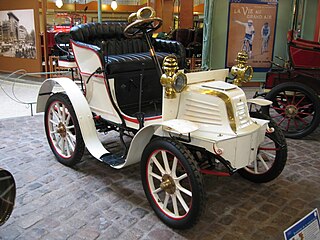
Peugeot is a French automobile brand owned by Stellantis.

The Peugeot 205 is a four-passenger, front-engine, supermini (B-segment) car manufactured and marketed by Peugeot over a sixteen-year production run from 1983 to 1999, over a single generation. Developed from Projet M24 and introduced on 25 February 1983, the 205 replaced the Peugeot 104 and the Talbot Samba, using major elements from their design. It won What Car?'s Car of the Year for 1984. It was also declared "car of the decade" by CAR Magazine in 1990. Peugeot stopped marketing the 205 in 1999 in favor of its new front-engined 206. The 106, which was introduced in 1991, effectively took over as Peugeot's smaller front-engined model in their lineup. The 106 was indeed developed as a close sibling of the Citroën AX, sharing many components and a platform that later evolved into the Citroën Saxo.

Panhard was a French motor vehicle manufacturer that began as one of the first makers of automobiles. It was a manufacturer of light tactical and military vehicles. Its final incarnation, now owned by Renault Trucks Defense, was formed by the acquisition of Panhard by Auverland in 2005, and then by Renault in 2012. In 2018, Renault Trucks Defense, ACMAT and Panhard combined under a single brand, Arquus.

The Peugeot 504 is a mid-size, front-engine, rear-wheel-drive automobile manufactured and marketed by Peugeot from 1968 to 1983 over a single generation, primarily in four-door sedan and wagon configurations – but also as twin two-door coupé and cabriolet configurations as well as pickup truck variants.

A multi-valve or multivalve engine is one where each cylinder has more than two valves. A multi-valve engine has better breathing, and with more smaller valves may be able to operate at higher revolutions per minute (RPM) than a two-valve engine, delivering more power.

The Peugeot Pars, previously known as Peugeot Persia and Peugeot Safir, is a passenger car produced by the Iranian carmaker Iran Khodro. After 10 years of manufacturing the Peugeot 405 in Iran, the company designed the Peugeot Persia as its facelift, with a front end design similar to that of the Peugeot 406. The Peugeot Persia was soon renamed Peugeot Safir and eventually Peugeot Pars because of local copyright problems.

The Peugeot Type 36 was a new model from Peugeot made in 1901 and 1902. It was the first Peugeot to feature a steering wheel rather than a tiller. The Type 48 also used a newly developed upright single-cylinder made by Peugeot. On this vehicle, the engine was available in four states of tune, offering between 5 and 8 bhp.

The Peugeot Type 105 was a large vehicle unveiled by Peugeot in 1908. The available body styles included double phaéton, landaulet, limousine, and sport. However, most were built as closed-top limousines. Total production lasted less than two years and saw the production of 23 units. Low production numbers and many available styles ensured almost complete uniqueness of each Type 105.

The Peugeot Type 177 B was a mid-range car produced between 1924 and 1929 by the French auto-maker Peugeot. With a fiscal horsepower of 10 CV, and a wheel base of 2670 mm, it competed in the same sector as the Citroën B2 and Renault KZ.

The Peugeot Type 156 was a large car announced in 1920 and produced between 1921 and 1923 by the French auto-maker Peugeot at their Sochaux plant. It was Peugeot’s first large car since before the First World War and its arrival recalled the Peugeot Type 135 which had ceased production in 1913. However, the 156 was larger and more powerful.

The Peugeot Type 173 is a mid-range car produced between 1922 and 1925 by the French auto-maker Peugeot at their Beaulieu plant. It replaced the company's celebrated Type 163 which itself had done much to revive the company's fortunes in the difficult years directly following the First World War.

The Peugeot Type 57 is an early motor vehicle produced in 1904 by the French auto-maker Peugeot at their Audincourt plant. 149 were produced.

The Peugeot Type 27 is an early motor vehicle produced between 1899 and 1902 by the French auto-maker Peugeot at their Audincourt plant. Only 29 were produced. This automobile had a brougham car body, similar to the older brougham carriage.

The Peugeot Type 126 is an early motor car produced in 1910 by the French automaker Peugeot at their Audincourt plant. 350 were produced.
The Peugeot Type 68 is an early motor car that the French auto-maker Peugeot produced at their Audincourt plant during 1905. 276 were produced.

The Peugeot Type 63 is an early motor car designed by Armand Peugeot and produced by the French auto-maker Peugeot at their Audincourt plant in 1904. 136 were produced, divided between shorter wheelbase Type 63As and longer wheelbase Type 63Bs.
The Peugeot Type 118 is a motor car produced by the French auto-maker Peugeot at their Audincourt plant in 1909. 150 were produced.

The Renault Vivasport was a 6-cylinder engined executive automobile introduced by Renault in September 1933 and produced till April 1935. A larger engined version was produced between December 1934 and February 1938. As with many Renaults during the 1930s, type changes as well as small often cosmetic facelifts and upgrades appeared frequently.

Ernest Henry was a mechanical engineer. He developed auto racing engines, and is especially well known for his work for Peugeot and Ballot, who dominated Grand Prix auto racing from 1912 to 1921. His engine design directly influenced Sunbeam Racing cars as early as 1914; the 1921 Grand Prix Sunbeams owe much to his work with Ballot and the 1922 Grand Prix Sunbeams were designed by him.

















